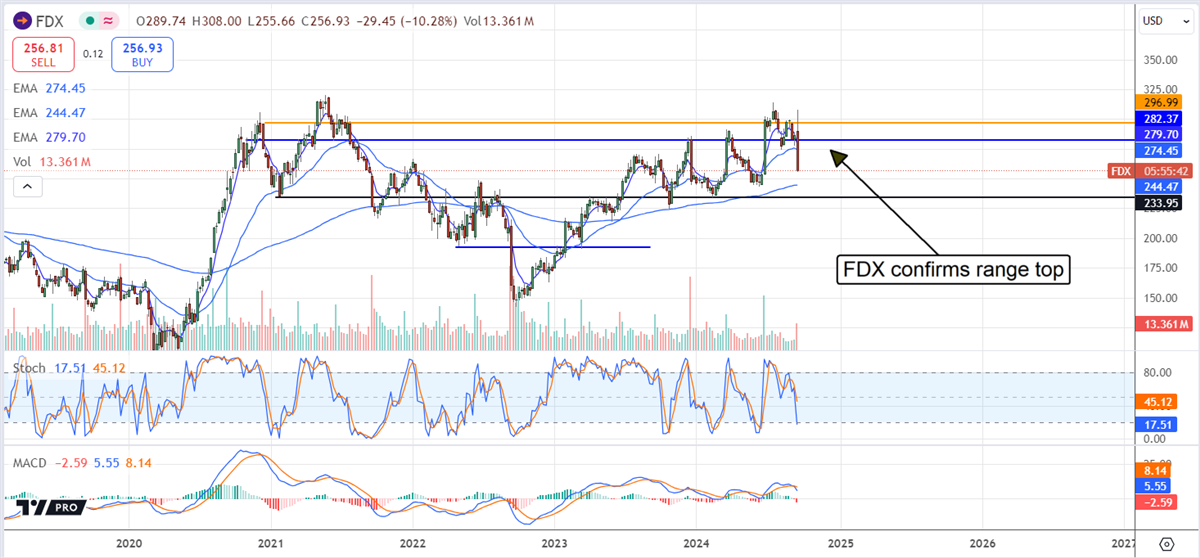FedEx Corporation FDX is a stalwart in the business realm, yet its recent stumble has sent shivers down investor spines, hinting at a looming economic precipice. The company’s lackluster performance across all fronts, falling short of growth projections and revising guidance downwards, may just be the initial tremor in what could be a series of downward revisions. The repercussions of FedEx’s news reverberated throughout the transportation sector, dragging down share prices of rivals like United Parcel Service and J.B. Hunt Transportation Services JBHT.
As the third-quarter earnings season looms, expectations are bleak, with concerns not just about corporate performances but also the broader economic backdrop. The fact that FedEx, a bellwether for the economy, failed to grow this quarter sets a somber tone for upcoming data releases, painting a grim picture for the stock market at large.
Shifting Consumer Trends Compromise FedEx’s Growth Trajectory
Despite a reasonably strong financial quarter, marked by steady revenue and profits adequate to fuel ongoing operations and capital return initiatives, FedEx’s net revenue of $21.16 billion took a hit, sliding 40 basis points year-over-year and falling short of consensus estimates by 140 basis points. Margin erosion further weighed down on the bottom line.
The drop in revenue is attributed to a shift in consumer preferences, as individuals opt for cheaper, albeit lower-margin shipping choices, shunning pricier priority shipping. Both operating segments felt the pinch of this trend, exacerbated by a day less in the quarter. Even after adjusting for this calendar quirk, the results still fell below expectations, compounded by lackluster guidance tainted with a tinge of optimism.
Margins paint a mixed picture. While FedEx made headway in its DRIVE initiative and enhancing structural efficacy, the consumer shift took its toll, squeezing margins that regressed compared to the previous period, exacerbated by rising wage costs. Operating margins witnessed a decline of 180 bps on a GAAP basis and 170 bps on an adjusted basis, leading to a 23% drop in net income and a 20% decrease in adjusted EPS. The EPS figures were somewhat buoyed by share repurchases, amounting to $1 billion in Q1, exerting a $0.03 impact on EPS, with another $1.5 billion buyback anticipated by year-end.
Guidance, though not entirely dismal, leaves room for improvement. Revenue and earnings appear robust to uphold operational and balance sheet integrity, with revenue anticipated to trend upwards by the year’s close. However, softened demand and the consumer trend shift in Q1 will likely hinder growth. Forecasts have been tempered, with revenue targets revised from mid-single digits to low single digits, and earnings narrowing towards the upper end, though these figures might be somewhat optimistic. Economic headwinds are unlikely to abate in the upcoming quarters, with the Federal Reserve’s interest rate cuts set to kick in only over the longer haul.
Analysts Pare Expectations for FedEx, Brace for a Bumpy Ride Ahead
The investment community’s discontent with FedEx’s recent performance is palpable, as a slew of analysts slashed their price targets post-earnings release. MarketBeat’s tracker highlighted a flurry of revisions within hours of the report, with numerous downward adjustments and several downgrades. This collective sentiment has dragged consensus price targets lower, capping any upside potential within a narrow trading range. Yet, amidst this pessimism, a solitary upward target revision provides a glimmer of hope, with the prevailing consensus suggesting that FedEx remains a buy, poised to rebound to higher echelons if subsequent reports cast a more favorable light.
The market’s response mirrors this sentiment, showcasing staunch resistance at the upper threshold of the trading range following a 15% plunge post-earnings. This resistance likely signals further downside pressure in the weeks ahead. A key support level to watch stands near $235, a threshold that may soon be tested. The risk looms large as market sentiments sour further, potentially pushing FDX stock out of its stable range towards the ominous $200 mark or even lower. Savvy investors keen on capitalizing on this downturn should consider tracking FedEx closely, awaiting a bottoming-out that aligns with a rosier economic outlook.

The article “FedEx Stock Dips: Another Reason to Fear Recession Is Near” first appeared on MarketBeat.
Market News and Data brought to you by Benzinga APIs
